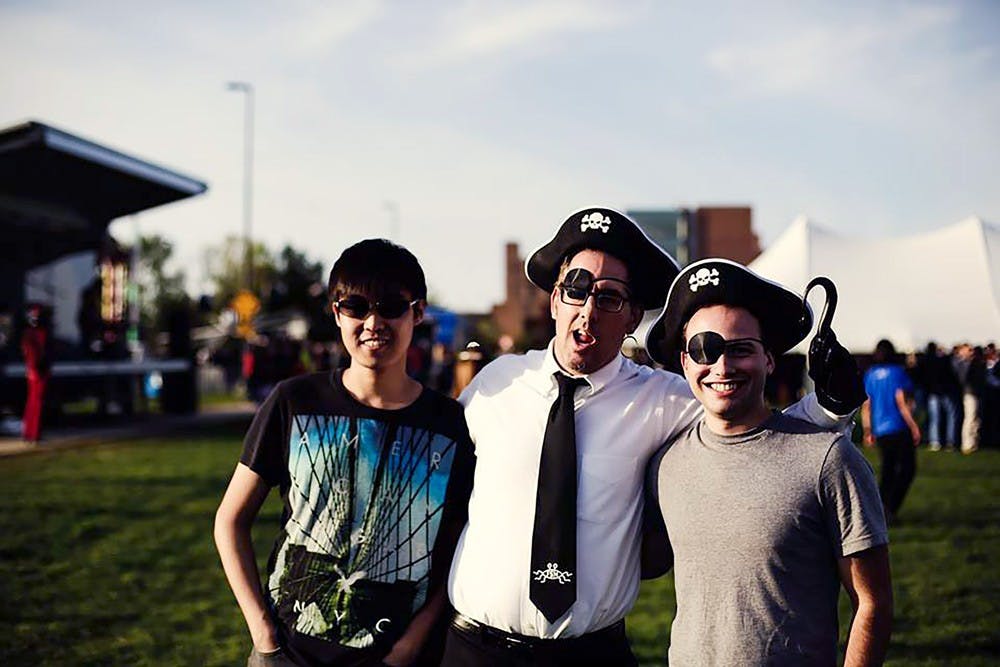They start their meetings like any other club, discussing club topics and issues. Then they move on to eating pasta while discussing the latest scientific news.
Welcome to UB Pastafarians.
Jonathan Sessler, a senior biological sciences major and president of the club, and Todd Fiore, a senior biomedical sciences major and vice president of the club, created the group based on Pastafarianism, a movement that promotes a light-hearted view of religion and opposes faith-based education in public schools. The two formed UB Pastafarians to discuss satirical comedy and science.
“We are not an atheist club as many believe,” Sessler said. “We encourage all to come and participate.”
The Church of the Flying Spaghetti Monster (FSM) is believed by followers to have existed in secrecy for hundreds of years, until it became mainstream in 2005. The Flying Spaghetti Monster, a floating mash of spaghetti and meatballs with eyes, is the deity of Pastafarianism, according to venganza.org, the official website of the church.
The club is based off the Church of the Flying Spaghetti Monster, though they place less emphasis on religion and more emphasis on satire.
Fiore said Pastafarianism is interesting because he thinks it’s a place mentally, emotionally and scientifically of love and celebration, where violence, discrimination, sexism, poverty and war are unacceptable.
He enjoys discussing heavy topics of the world because, as a scientist, they’re is “paramount.”
Sessler said satire is a popular way to get points across, like in shows like The Daily Show and Last Week Tonight.
“For the most part, I do look at [Pastafarianism] as satirical, however it brings in its own aspects and could be a true religion,” Sessler said.
He pointed out, however, the club does not place any focus on religion, but instead focuses on the satirical and cultural aspect of Pastafarianism.
As a club, they find amusement when cultural history – people, their social behaviors and their superstitions – is disregarded or shown to be false by the statistics and data of science.
“We hope that our club is a place people can discuss science topics whether current or old and have fun while doing it,” Sessler said. “That’s where the Pastafarian culture comes in.”
Pastafarianism is growing in popularity throughout the country.
Last year, Christopher Schaeffer, a Pastafarian minister, was sworn into a town council in Pomfret, New York.
Schaeffer is an active member of the Church of the Flying Spaghetti Monster, which to Schaeffer is just a practice of religious freedom, according to The Huffington Post.
Being an untraditional student, Fiore was not involved in any clubs before Pastafarians, which he considers to be an incredibly active club.
The club is still in its early stages and not officially recognized as an SA club. During meetings, the members participate in discussions and coordinate events and community service opportunities. They also use satire to discuss global topics. Community outreach and service is a big part of the club’s ambitions, too.
The club wants to become a permanent club at UB, with Sessler having high hopes of others carrying it on for future students.
“In the beginning many people just laughed and didn’t really know what to make of us,” Sessler said. “But a semester later, they are seeing that we are putting the effort in.”
The number of people who come to meetings has varied but there is an average of 10-15 people at each one.
“Meeting all the open minded, super intelligent people is probably my favorite part,” Fiore said. “They are too humble and kind because they value and respect all others no matter what their interest for future endeavors involve.”
Daniel McKeon contributed reporting to this story.
email: features@ubspectrum.com





